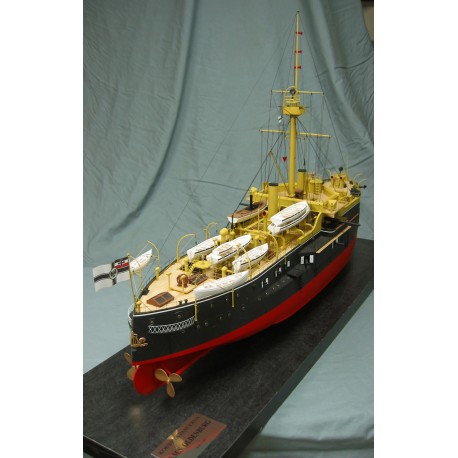SMS OLDENBURG
New product
S.M.S. OLDENBURG Armoured Corvette
Scale 1/100
National Maritime Museum
More info
S.M.S. OLDENBURG Armoured Corvette
The turn of the 19th century was marked with tremendous development in technology, metallurgy and manufacturing methods. The change had also a great impact on the shipbuilding industry. Technological contest included armour, calibre and variety of guns, propulsion, and utilization of technical innovations. As a result, the suitability of newly built warships was very often illusive and short-term. The dreadnought of S.M.S. Oldenburg was a good example.
In 1881, the core of German flotilla consisted of four SACHSEN Class dreadnoughts, commissioned over the years 1878 to 1883. They had been built at German shipyards in accordance with the flotilla foundation plan developed in 1873 by the then head of admiralty, Lieutenant General Albrecht von Stosch, and joined to the remaining older warships of PRUSSIA and KAISER Class: KÖNIG WILHELM, HANSA, FRIEDRICH CARJ and KRONPRINZ. Furthermore, the von Stosch’s plan provided for the construction of two new vessels. One of those vessels was to replace the dreadnought of PRINZ ADALBERT decommissioned in 1871, the other was to be the next armoured corvette to increase the flotilla size. In the fiscal year 1879/1880, the desideration was put forward for approval by the Reichstag and it was rejected.
In 1881, the admiralty again submitted a motion to replace PRINZ ADALBERT and to build a new corvette, “E”. However, the admiralty’s representatives again failed to force their plans in full. The Reichstag did not accept the plan to build a replacement vessel, and only limited financial resources were granted for the construction of “E” armoured corvette, later known as OLDENBURG.
Although in the projects developed during 1879-1881, it was envisaged that a new vessel would be of Sachsen Class, the missing three million reichsmarks brought about probably the most unsuccessful vessel of the Imperial Navy. The keel was laid down in the autumn of 1883 in Wulkan Shipyard in Szczecin, as construction site No 132, and the hull was launched on 20th December 1884. This casemate vessel with a hull in system of transverse and longitudinal ribs was the first in Germany to be built entirely of steel. The hull was divided into twelve compartments and featured double bottom in 60 percent of its length. Inside two main engine rooms, there were two four-cylinder double-expansion engines, which propelled two ship’s screws 4.5 metres in diameter. Steam was supplied by eight crosswise arranged boiler drums installed in two boiler rooms. Electric energy was delivered by three 65-Volt generators with rated power of 29 kW.
On the water line, the hull was covered with combined armour on wooden layer. The upper layer was 200 to 300 mm deep, the lower layer 180 to 250 mm deep. The casemates were sheltered with armour 150 to 200 mm deep on wood. The upper part of the hull was covered with 15-milimetre plates; below there was an armoured deck 30 mm deep stretching from bow to stern. The command station was sheltered with plates 25 to 60 mm deep.
Despite the fact that Oldenburg had artillery advantage over Sachsen-Class vessels, she failed to produce the planned effect. Due to her low speed, she was often an obstruction for accompanying squadrons instead of intended reinforcement that had been hoped for when giving acceptance to build the vessel.
Technical data:
Displacement 5743 tonnes
Length 79.80 m
Width 18.00 m
Draught 6.30 m
Crew 34 officers and 355 seamen
Construction cost 8 885 000 Reichsmark
Armament 8 guns, 24 cm / L30, 494 shots
4 guns, 15 cm / L22 (temporarily)
2-8 guns, 8.7 cm / L24 (finally 2)
6 quick-firing guns, 5 cm / L40 (instead of 8.7)
4 torpedo tubes, 35 cm
(other sources also state 6x3.7 cm and 4x8 mm)

























